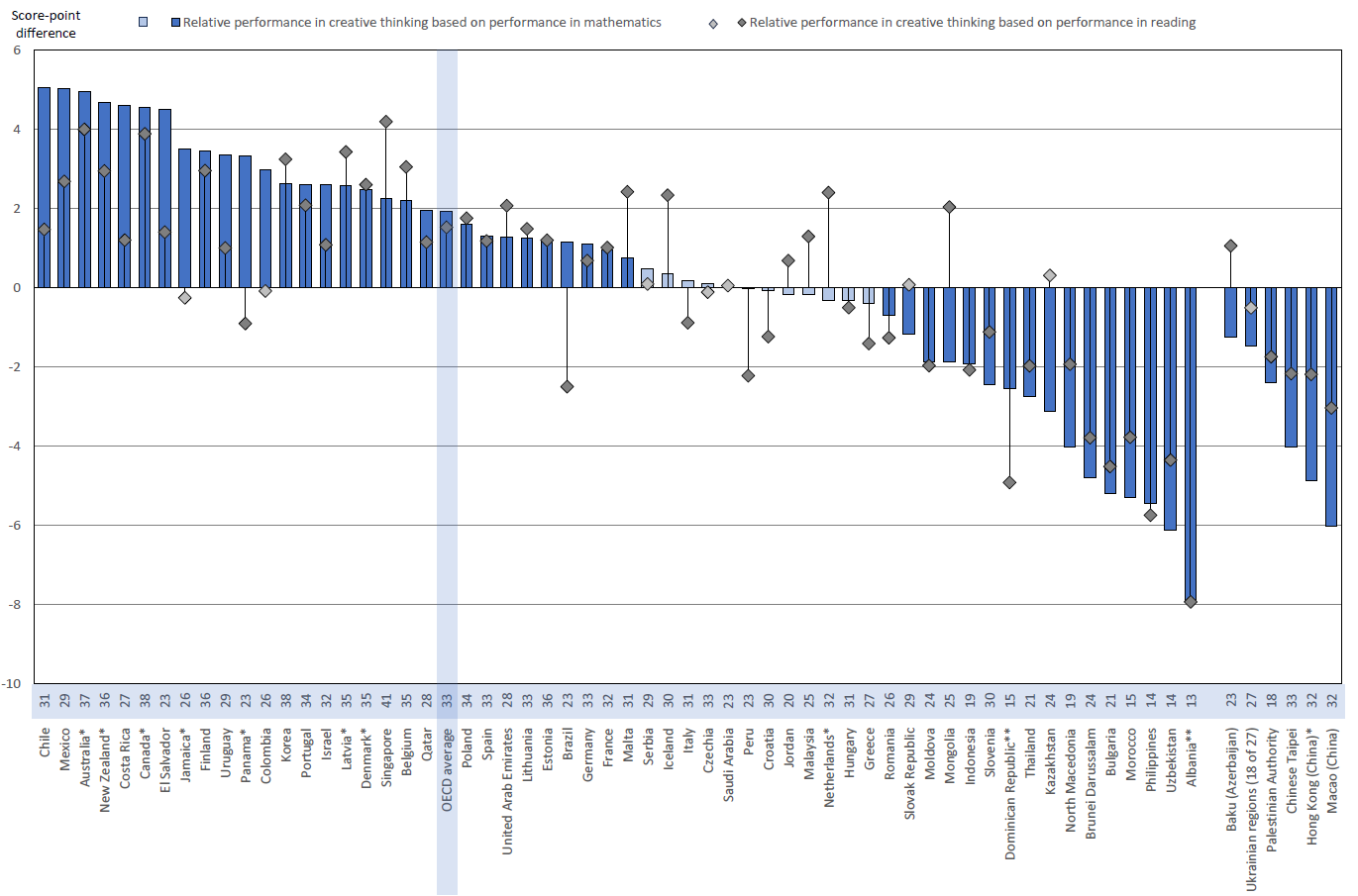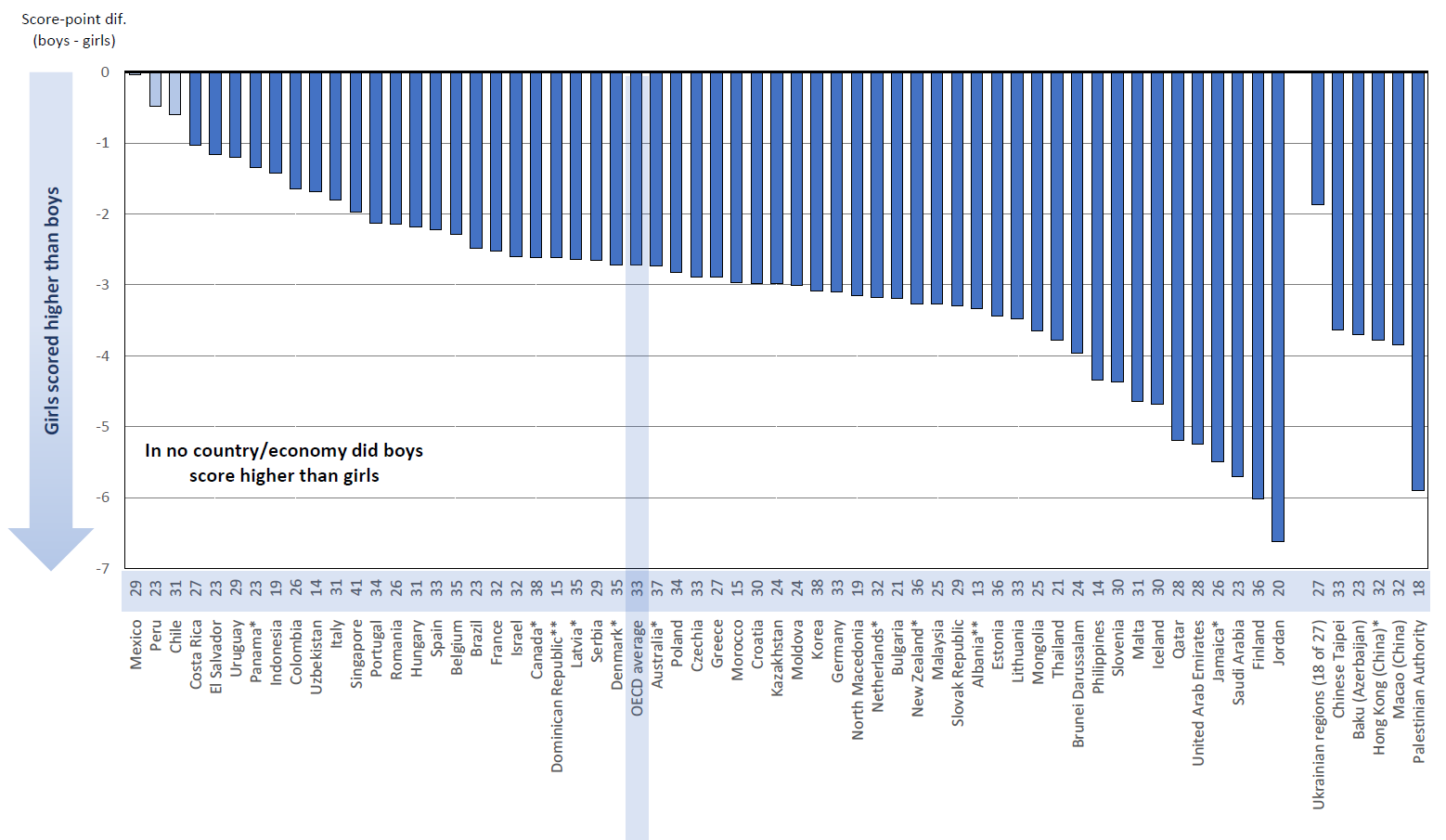Singapore scored significantly higher than all other participating countries/economies in creative thinking. Students in 11 other countries performed above the OECD average: Korea, Canada*, Australia*, New Zealand*, Estonia, Finland, Denmark*, Latvia*, Belgium, Poland and Portugal, in order of performance. Education systems that scored highly in creative thinking almost always performed highly in mathematics, reading and science. However, about half of students who excelled in creative thinking did not excel in academic domains, on average across OECD countries. The results suggest that academic excellence is not a pre-requisite for excellence in creative thinking. However, a minimal level of proficiency in one domain complements proficiency in the other.
Creative thinking
In its 2022 cycle, PISA measured 15-year-old students’ creative thinking for the first time. This was defined as the capacity to produce diverse and original ideas, as well as to evaluate and improve upon others’ ideas. In today’s world, students need to be able to think creatively and adapt to new methods and perspectives to tackle emerging challenges. In the future, societies will increasingly depend on innovation and knowledge creation to address the issues they face.

Key messages
Girls have more positive beliefs about creativity in general and in their capacity to do creative work; and they feel more imaginative and open to perspective taking. Together with curiosity, openness to intellect and persistence, those are characteristics associated with stronger creative thinking. Socio-economically advantaged students outperformed their less advantaged peers, though the strength of the association between socio-economic status and performance is weaker in creative thinking than for mathematics, reading and science.
Equipping students with the creative thinking skills they will need throughout their life requires a comprehensive set of policies and changes in everyday schooling practices. Promoting the development of creative thinking consistently and effectively in education requires educators, curriculum developers and assessment designers to have a shared understanding of what creative thinking is, how students can develop creative thinking skills, and how their progress can be measured. Redefining curricula and learning progressions explicitly with these goals in mind can facilitate the development of creativity-supportive teaching and learning.
Context
Some education systems performed above expectations given previous PISA
Performance in creative thinking was positively correlated with performance in the PISA core domains, but less strongly than reading, mathematics and science were correlated with one another. In other words, good results in mathematics at the system level are more often accompanied by good results in science and reading, than they are by good results in creative thinking.
Countries’ and economies’ relative performance in creative thinking (2022)
Score-point difference between actual and expected performance in creative thinking

Academic excellence is not a prerequisite for creative thinking, but minimal proficiency helps
Which students perform the best in the creative thinking test? Not always the top academic performers. There is a complementary relationship between creative thinking and academic performance, but just to some extent – particularly at the upper and lower ends of the proficiency scales. This makes sense: without a minimum level of knowledge and experience in a given domain, it would be challenging to generate appropriate, diverse or original ideas.
Distribution of students across quintiles of performance in creative thinking and mathematics (2022)

Girls outperform boys in creative thinking in all types of tasks
In no country or economy do boys outperform girls in creative thinking. Girls particularly excel in written expression tasks and those requiring them to build on others’ ideas. And this is not only a question of academic performance. Girls generally have more positive beliefs about creativity and their own ability to engage in creative work. They also display several attitudes and socio-emotional skills positively associated with creative thinking such as imagination, openness to art and experience and perspective taking.
Gender gap in creative thinking performance (2022)

Related publications
Programmes and projects
-
PISA is the OECD's Programme for International Student Assessment. PISA measures 15-year-olds’ ability to use their reading, mathematics and science knowledge and skills to meet real-life challenges.Learn more
-
The Research, Development and Innovation (RDI) programme established by the PISA Governing Board in 2018 explores how different areas of the assessment programme (e.g. test design, scoring methodologies) can be improved.Learn more
-
The Centre for Educational Research and Innovation (CERI) provides and promotes international comparative research, innovation and key indicators, explores forward-looking and innovative approaches to education and learning, and facilitates bridges between educational research, innovation and policy development.Learn more
-
The Education Policy Outlook is an analytical observatory that monitors the evolution of policy priorities and policy developments from early childhood education to adult education, mainly among OECD education systems, to provide a comparative understanding of how policies are evolving, and how they can be best implemented or improved over time.Learn more
-
OECD Future of Education and Skills 2030 aims to build a common understanding of the knowledge, skills, attitudes and values students need in the 21st century.Learn more
-
The PISA-based Test for Schools provides school-level estimates of performance and information about the learning environment and students’ attitudes gathered from student questionnaires. Find out more and how schools and their networks can take part.Learn more
-
Creativity and critical thinking prepare students for innovative economies and improve wellbeing. However, educators often lack guidance on how to equip students with creativity and critical thinking within subject teaching. Education systems have likewise rarely established ways to systematically assess students’ acquisition of creativity and critical thinking.Learn more






